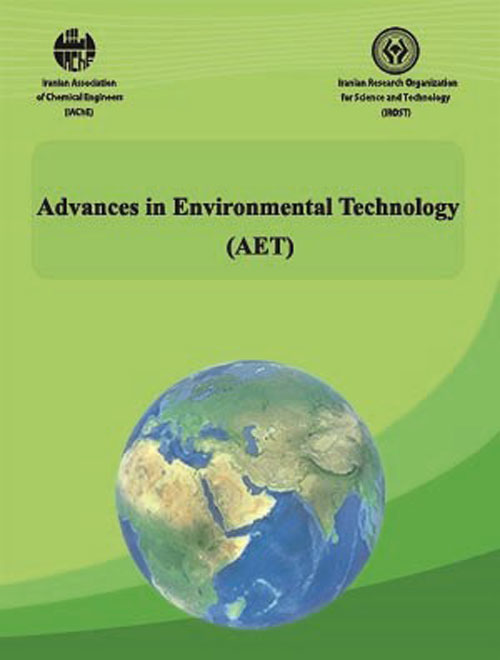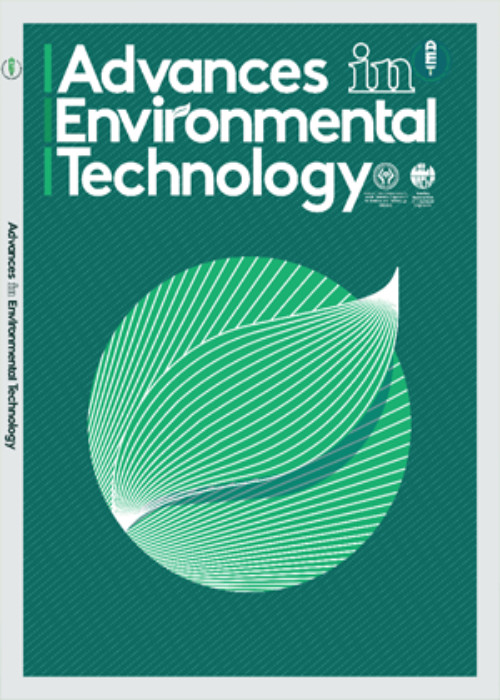فهرست مطالب

Advances in Environmental Technology
Volume:3 Issue: 4, Autumn 2018
- تاریخ انتشار: 1396/11/17
- تعداد عناوین: 6
-
-
Pages 187-195
Magnetic chitosan nanocomposites are one of the more recent advanced groups of adsorbents used to remove contaminants from waste water. In this research, N- Nicotinyl-N', N"-bis (Hexamethylenyl) phosphoric triamide (HE) was used as an additive to form a new nanocomposite with the structure of chitosan / 5% Fe3</sub>O4</sub> Nps/10% HE resulting in the highly efficient removal of Cd(II) ions from an aqueous solution. Several techniques were applied to characterize the new-fabricated nanocomposite: X-ray Powder Diffraction (XRD), Energy Dispersive X-ray Spectroscopy (EDX), Field Emission Scanning Electron Microscopy (FE-SEM), Fourier transform infrared (FTIR) and vibrating sample magnetometer (VSM). Atomic Absorption Spectroscopy (AAS) was used to measure the removal percentage of Cd(II) ions from the contaminated water samples. Results showed that 15 mg of the nanocomposite could remove Cd(II) ions with a rate of 99.9% from 20 mL of its 100 ppm aqueous solution in pH=9 with contact time of 1h. Furthermore, the same amount of the nanocomposite was applied to remove Cd(II) ions from 20 mL of a real wastewater sample with a pH=9 and the same contact time. The resulting removal rate of Cd(II) ions was 99.5%.
Keywords: Removal of Cd(II), Magnetic chitosan nanocomposites, Additive, N- Nicotinyl phosphoric triamide Amine -
Pages 197-202
In today's world, the production of hospital wastes and their adverse effects such as infectious outbreaks and resistance to treatment is an important issue. Therefore, it's vital to find a new and efficient method to manage such wastes. In this study, the ability of dielectric barrier discharge (DBD) plasma to deactivate Pseudomonas aeruginosa</em> and Staphylococcus aureus</em> bacteria was assessed. The bacteria were treated with DBD plasma after cultivation in liquid milieu, and then dried in a sterile air stream. The results showed that for both bacteria, the number of deactivated colonies increased proportionally to the time of treatment. First, it occurred rapidly, and then the number of active colonies decreased at a slower speed. Also, increasing the plasma duty cycle in the same treatment time led to more deactivated colonies. This increase was more significant in the Pseudomonas</em> aeruginosa</em> bacteria, and changes for the Staphylococcus</em> aureus</em> was slight.
Keywords: Dielectric barrier discharge, Cold Plasma, Sterilization, Pseudomonas aeruginosa, Staphylococcus aureus, Deactivation -
Pages 203-209
In this research, commercial nano-clay (NC) was modified with TiO2</sub> functional groups and characterized via XRD and FTIR methods. The modified nano-clay was applied as an adsorbent for the removal of cadmium from wastewater solutions. The effects of the operating parameters including initial pH, cadmium concentration and adsorbent concentration were analyzed by the Taguchi method. The optimum conditions for cadmium removal by the nanoclay/TiO2</sub> composite were an initial feed pH of 6, an initial concentration of 30 mg/L, and an adsorbent concentration of 4.5 g/L. Under these conditions, nearly 90% of the cadmium ions were removed by modified nano-clay after one hour. The equilibrium results showed that the Freundlich model could well fit the experimental data, and this indicated the multilayer adsorption process. The adsorption capacity of the nano-clay for cadmium improved from 8.92 mg/g to 16.20 mg/g by modification with TiO2</sub>. The kinetic data were analyzed using the pseudo-first order, pseudo-second-order, and intraparticle kinetics models. Thermodynamic studies indicated the exothermic and spontaneously nature of the adsorption process.
Keywords: Nanocaly, Adsorption, Cadmium, Modification -
Pages 211-221
Despite the fact that there are wastewater treatment plants (WWTPs) currently operational across Iran and great advances have been made in this area, there are still problems in the design, construction, and operation of WWTPs with large nonlinear systems, varying flow rates, and pollution charges. The objective of this study was to investigate the effect of operating parameters including the return activated sludge (RAS) ratio, internal recycle (IR) ratio and dissolved oxygen (DO) concentration in an activated sludge system for the Modules 5&6 of the Southern Tehran WWTP. This study designed and simulated a plant based on the activated sludge model No.1 (ASM1) to determine the factors affecting wastewater treatment systems; then, the kinetic parameters were measured. The kinetic parameters such as the yield coefficient (Y), decay coefficient (Kd), maximum specific growth rate (K), and saturation constant (Ks) were in the range of 0.303-0.331g/g, 0.030-0.033d-1, 1.65-1.93d-1 and 37.6-44.92mg/l, respectively. The RAS ratios, IR ratios, and DO concentration varied from 0.2 to 2, 1 to 3.5, and 0.27 to 3.54 mg/l, respectively. The amount of RAS had the greatest impact on the effluent. The amounts of IR and DO concentration had no significant effect on the concentration of the five-day biochemical oxygen demand (BOD5), chemical oxygen demand (COD), and total suspended solids (TSS) in the effluent. After the RAS, the amount of IR had the most direct effect on reducing the effluent total nitrogen (TN) concentration. As a result, the overall removal efficiency increased up to 75% when the IR rate was 200% of the influent flow rate, the RAS rate was 90% of the influent flow rate, and the DO concentration in the first aeration unit was 2 mg/l considering the aeration cost. Therefore, proper operating parameters can provide the best quality of effluent that meets environmental standards.
Keywords: Simulation, Activated Sludge Model No.1, Return Activated Sludge, Internal Recycle Flow, Dissolved Oxygen, Concentration -
Pages 223-231
The present work focuses on the synthesis and application of imine-modified silica-coated magnetic (IM-SCM) nanoparticles. The X-ray diffraction (XRD) tests indicated the presence of highly crystalline cubic spinel magnetite both before and after coating with the silica. The FTIR spectra also proved the successful surface coating and imine-modification of the Fe3</sub>O4</sub> nanoparticles. Further investigations were performed to examine the capability of the modified IM-SCM nanoparticles for simultaneous removal of Ag+</sup> and Cu2+ </sup>from the water samples. Atomic absorption spectrometry was used for ion determination. The best operating conditions for removing the target ions were a pH=5-9 and a stirring time=30 min. Only 20 mL of 3M nitric acid was used for stripping the ions using the IM-SCM nanoparticles. The resulting data were found to fit well with the Langmuir model, and the maximum capacity of the adsorbent was determined to be 270.3 (± 1.4) mg and 256.4 (± 0.9) mg of Ag+</sup> and Cu2+ </sup>/g of IM-SCM, respectively. The adsorbent was successfully used for simultaneously removing the target ions from the wastewater samples.
Keywords: Ag+, Cu2+, Imine-modified silica-coated magnetic, nanoparticles, Removal, Wastewater -
Thermodynamic study of CO2 hydrate formation in the presence of SDS and graphene oxide nanoparticlesPages 233-240
Gas consumption rate is an important factor in the kinetic study of gas hydrate formation. In this study, the kinetic of the hydrate formation was examined in water + carbon dioxide + graphene oxide and water + carbon dioxide + graphene oxide + sodium dodecyl sulfate (SDS) systems. The experiments are carried out at 0.05 and 0.1%of graphene oxide nanoparticle weight and 400 PPM SDS solution at 3.6 MPa and 4 MPa pressures and temperatures of 275.65, 277.65, and 279.65 K. The results show that as the pressure rises, graphene oxide is responsible for the increase in the storage capacity and gas consumption at constant temperature so that using graphene oxide at 0.1% weight increases the storage capacity by 4.2% and molar gas consumption by 3.8% at the pressure of 3.4 MPa compared to the 0.1% weight. When the surfactant, SDS with the concentration of 400 ppm, is used, storage capacity and gas consumption increase by 38% and 26%, respectively.
Keywords: Clathrate hydrate, Graphene oxide, Storage capacity, SDS, Gas consumption


